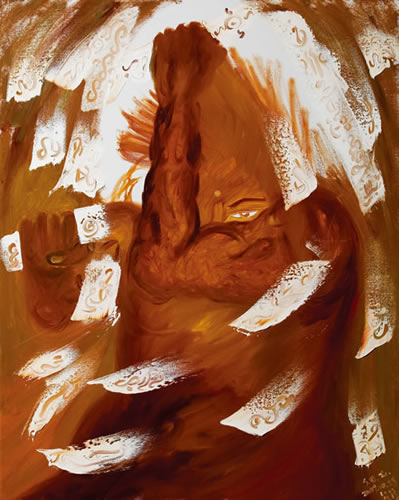

 字體:小 中 大
字體:小 中 大 |
|
|
|
| 2007/12/18 23:39:17瀏覽880|回應0|推薦4 | |
The Mind in Freedom: The Paintings of Master Lee Sun Don By Eleanor Heartney 自由的心靈: 李善單大師的繪畫 作者: 艾樂諾賀特妮 (註:Eleanor Heartney為美國著名藝術評論家及作家,著有多本藝術評論書籍及論文,目前為AJCA/USA美國國際藝術家評論協會前會長,擔任Art in America 及Artpress等雜誌的特約編輯,曾多次在華盛頓郵報、紐約時報等媒體發表評論。) Throughout history, Western art has frequently provided representations of states of spiritual transcendence – a tradition that encompasses works as diverse as Bernini’s St Theresa in Ecstasy, the majestic landscapes of
歷史上,西方藝術經常地提供了精神卓绝超然存在的表示法 – 這種傳統是多樣的,例如Bernini的St Theresa的狂喜、哈得遜河學派畫家Frederic Church 和 Albert Bierstadt所畫的莊嚴雄偉的風景、以及Mark Rothko的明亮抽象。西方較少見體現精神真相的藝術。在這樣的作品中,畫中的對象是經過設計,不僅只是激發熱愛或崇高的感覺,而是對觀畫者具有一種變化的作用,並能帶領他或她與神性的或超自然的能量產生直接感應。然而,在西方藝術傳統之外,甚至其邊緣,這種傾向則較為通常,形成一種藝術的類別,包括非洲相信的物神、拜佔庭式的聖像、和幻象派藝術家Ernst Fuchs和Arik Brauer的作品。 Created as a form of Buddhist practice, the vibrant paintings of Buddhist Master Lee Sun Don belong to this special category. A Buddhist Patriarch who follows the Yuan-Dao Bodhisattva, Master Lee was authorized as the third Dharma heir of Buddhist Forshang in 1993. He is also a teacher, entrepreneur, novelist, musician and founder of GP DEVA 佛學大師李善單充滿活力的繪畫屬於這個特別類別。跟隨緣道菩薩,并且在1993年被授記成為佛教佛乘的第三代法統繼承人,李導師的繪畫創作是一種佛法實踐的形式。李導師,他也是老師、企業家、小說家、音樂家及香華天˙新藝境企業的創辦人,該公司致力於社會公益和文化啟迪。1998年開始繪畫,運用線條、形式和顏色的視覺詞彙來表達佛教佛乘的教導中歡喜的本質。他的不羈,具意涵性的作品為狂喜、和諧、和沉思狀態作出抒情表達,並具體呈現宇宙間變化的能量。 From the perspective of the Western art critic, these works have a kinship with various strains of modernist and postmodernist art. In their spontaneity and freedom, they bring to mind the immersion in the moment that is a hallmark of process art, particularly as practiced by John Cage, who was himself a student of Buddhism. They also recall Kandinsky’s interest in art and spirituality and his efforts to find visual form for the ineffable energies and harmony of the universe. And of course, there is a connection between Master Lee’s direct and unfiltered images and the tradition of the self taught, visionary artists who channel visions of alternate realities through their art. 從西方藝術評論家的觀點,這些作品與現代主義者和後現代主義藝術中的各種調性確有氣質上的類似。就作品的自然和自由,這些作品中的沉浸於片刻,讓人想起過程藝術的特徵,特別是約翰‧凱吉(John Cage)的作品,他本身也是佛教弟子。這些作品也讓人想起康丁斯基(Kandinsky) 對藝術與靈性的興趣,以及他努力發掘視覺形式以表達宇宙的無法表達的能量和和諧。當然,李導師的直接和未經過濾的圖像,與自學的幻象派畫家們通過藝術傳達各種面貌的真實的傳統是有著關連的。 However from the perspective of Buddhist thought, such familiar critical issues are secondary to the larger meaning of these works as exemplars of Buddhist practice. Master Lee’s paintings are imbued with Buddhist teachings about the oneness of nature, the impermanenceof visible reality and the need for mindful awareness of the surrounding world. Painted in a style that melds Asian and Western traditions, they contain elements of Asian calligraphy and western expressionism. In an innovative departure from traditional Buddhist paintings, normally realized in ink on paper, they are painted in oil on canvas. Each contains a “totem”, a symbol of universal energy and harmony, apprehended in the process of deep meditation. Both the brushstrokes and the colors express various aspects of the Dharma. (Red, for instance, refers to elimination of the apparent afflictions, contradictions and chaos of the world through spiritual enlightenment, while purple embodies the bestowal of blessings and fortune while yellow and white stand for wisdom.) Each totem is designed to spark a sense of enlightenment and transcendence in the viewer. 然而就佛教思想的觀點,相較於這些作品作為一種佛法實踐的典範的更大意義而言,這些常見的評論上的重要問題卻是次要的。李大師的繪畫充滿了佛法,關於自然的一體性,可見的現實的無常,和需要對周圍世界用心瞭悟。這些作品融合亞洲和西方的傳統風格,其中包含亞洲書法和西方表現主義的元素,同時以一種創新而離開傳統佛教繪畫方式—通常是以水墨畫在絹紙上的,而它們是用油彩作畫的方式來實現的。 其中每一幅都包含一「圖騰」,一種宇宙能量及合諧的標誌,由李大師以他在入深禪定中被體會出來,李大師繪畫的技巧和顏色均表達佛法的各種層面。(例如紅色,意指對世界上表相上的苦惱、矛盾和混亂以精神上的啟發來做一個清淨,而紫色顯示祝福和時運,黃色和白色則代表智慧。) 每一幅圖騰油畫都經過設計以激發觀畫者的覺悟與超越。 These expressive paintings contain images of landscapes, of devotees in meditation or at the moment of enlightenment, of musical instruments as metaphors for the harmonic energy of the cosmos, and of elements of everyday life transformed by Buddhist consciousness. Some works are whimsical. The Green, My Beloved (To Achieve Ultimate Freedom), a painting of a pair of frogs at the edge of a lotus pond, is a reminder that the Buddha nature exists in every living being. Accordance of all Dharmas suggests that for baseball players the meeting of the ball with the bat is a metaphor the kind of union of mind and body that is the essence of enlightenment. 這些意味深長的繪畫包含的圖像有風景,打坐中的修行者,或覺悟的剎那,樂器作為宇宙和諧能量的隱喻,以及日常生活的元素,皆是透過佛教修行者的覺知的轉換。一些作品是異想天開的。 綠色,我心愛(達到最後自由),一對青蛙在荷花池邊的這幅畫,是提示眾生皆有佛性。諸法相應意指對棒球選手而言,球與棒的交會隱喻身心合一是覺悟的本質。 Other paintings convey various emotional states. Ha Ha Ha, for instance, notes that laughter and joy are indispensable components of enlightened understanding. Heavenly Blessing to Those in Love, evokes a contemplative mood, presenting a couple in a romantic landscape setting overcome with a sense of beauty. The fiery red in Small Case (Fear and Matchless to Subdue all Evils) presents the warrior side of Buddhist practice, taking a stand against the forces that threaten peace and harmony. Meanwhile, Mindfulness Buddha Presence is a reminder that each of us carries the Buddha nature within ourselves. 其他的畫作表達了各種的精神層面。 以Ha Ha Ha為例,詮釋笑聲和喜悅是覺悟中不可或缺的成份。天祝有情人,喚起一種沉思的情緒,呈現一對夫婦置身於一處唯美的浪漫風景之中。 Small Case (能除一切惡)火紅之中呈現實踐佛法中的勇士的一面,採取立場對抗威脅和平和和諧的力量。同時,念佛在是提示我們每一人內心之中都有著佛性。 Even for a viewer not schooled in Buddhist teaching, the messageof these works is clear. Reality can be expressed in many forms and the one-ness of the universe is best understood by immersion in the world as we find it. Master Lee 即使沒有學佛的觀畫者,這些作品中的訊息十分明確。真實是可以用許多不同的形式來表達,對宇宙的一體性最佳的瞭解是透過我們與身處的世界合一。李導師的訊息是一種投入,而非退縮,覺悟意味著在世界表相上的混亂之下發現其中的美與和諧。
|
|
| ( 創作|文學賞析 ) |










